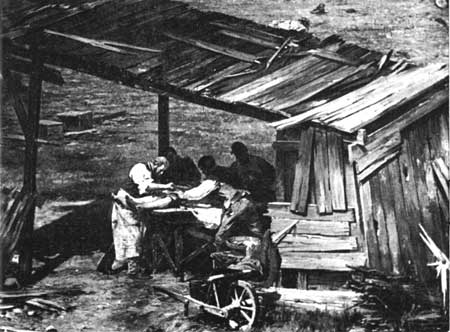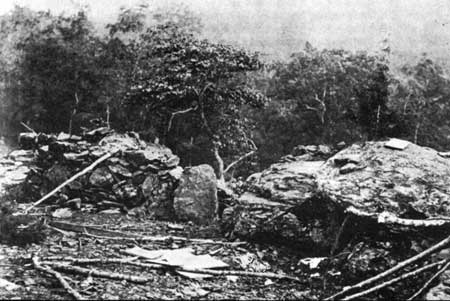|
GETTYSBURG National Military Park |
 |

Field hospital.
From the Cyclorama.
The Second Day (continued)
CULP'S HILL. In the Confederate plan, Ewell on the left was directed to attack Cemetery Hill and Culp's Hill in conjunction with Longstreet's drive. At the appointed time, the guns of Latimer's battalion on Benner's Hill, east of Gettysburg, opened a well-directed fire against the Union positions on East Cemetery Hill and Culp's Hill, but the return fire soon shattered many of Latimer's batteries and forced the remnants to retire out of range. In the final moments of this action the youthful Major Latimer was mortally wounded.
About dusk, long after the artillery fire had ceased, Johnson's division charged the Union works on Culp's Hill. Although his right failed to make headway because of the steep incline and the strength of the Union positions, Steuart's brigade on the left had better luck. Here, on the southern slope of the hill, the Union works were thinly manned. An hour earlier, the divisions of Geary and Ruger had been called from these works to reinforce the Union center. Johnson, finding the works weakly defended, took possession of them but did nor press the attack further. Only a few hundred yards away on the Baltimore Pike lay the Union supply trains. Failure of Confederate reconnaissance here again was critically important. Thus passed another opportunity to strike a hard blow at the Union Army.

Interior of breastworks on Little Round Top.
Brady
photograph.
Closely timed with Johnson's assault, Early's infantry started a charge toward East Cemetery Hill. Seldom if ever surpassed in its dash and desperation, Early's assault reached the crest of the hill where the defenders, as a last resort in the hand-to-hand encounter, used clubbed muskets, stones, and rammers. Long after dark, Early's Louisiana and North Carolina troops fought to hold the crest of the hill and their captured guns. But the failure of Rodes to move out of the streets of Gettysburg and attack the hill from the west enabled Hancock to shift some of his men to aid in repelling Early's attack. Faced by these Union reserves, Early's men finally gave way about 10 o'clock and sullenly retired to their lines. The Union troops stood firm.

|

|
|
Last Modified: Mon, Mar 4 2002 10:00:00 pm PDT |


